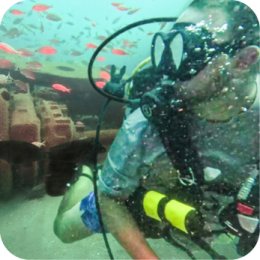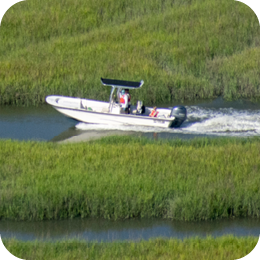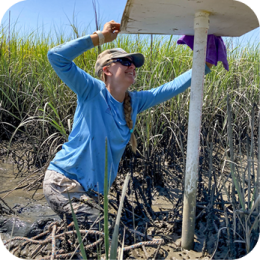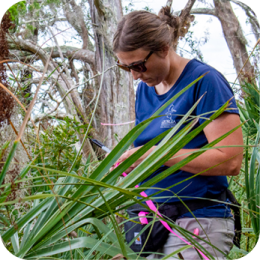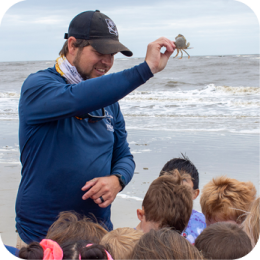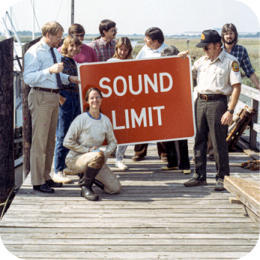To successfully manage our valued resources, there are many efforts being taken.
- Forestry Management
- Deer Management
- Prescribed Fire Management
- Botanical Services and Invasive Species Control
- Ecosystem Restoration
- Nuisance Animal Control
- Natural Georgia
Forestry Management
Encouraging a healthy natural community which increases both plant and wildlife diversity and strengthen the communal eco-system of each is the goal of our forestry management efforts.
Professional forestry management is critical in managing the division’s natural resources including:
- Habitat restoration and forestry health initiatives such as:
- Long leaf pine and wiregrass habitat restoration efforts at General Coffee, Reed Bingham, Magnolia Springs and George L. Smith
- Saving native hemlocks through partnerships with the Georgia Forestry Commission and the University of Georgia to control the hemlock wooly adelgid through chemical injection treatment on thousands of trees at Moccasin Creek, Black Rock Mountain, Tallulah Gorge, Smithgall Woods, Unicoi, Hardman Farm, Amicalola Falls
- Creating a timber revenue stream that provides a funding base for ongoing resource management initiatives
- Minimizing pine bark beetle and other predatory beetle damage by thinning timber tracks
- Work with Georgia Forestry Commission in monitoring:
- Other predatory species such as the sirex wood wasp, gypsy moth, Asian long horned beetle and emerald ash borer
- Diseases such as Red Bay disease first noticed at Stephen C. Foster and oak wilt disease
Deer Management
In partnership with Wildlife Resource Division and USDA APHIS Wildlife Services, State Parks & Historic Sites has been managing deer populations since 2003. Our primary method of deer reduction is to enlist the use of hunters during managed quota hunts.
Reasons for the necessity of our deer management efforts include:
- The impact of over population of deer on our natural resources on a social, ecological and biological levels
- The negative ecological impact on some state park properties where deer have overpopulated leaving both plant and wildlife communities heavily impacted due to over browse and conditions
In 2006 a Deer Advisory Committee was created that is comprised of wildlife biologists, university researchers, botanists and park resource management staff. The committee meets annually in January with parks region managers and site staff involved with potential hunts. Strategies are discussed to properly manage the division’s deer population based on the results of previous hunts, harvest data and biological recovery data. Proposals are sent to the DNR Board for incorporation of the states hunting regulations.
Since the initial reduction efforts we have partnered with the WRD Game Management section to survey selected parks for deer density and use population modeling based on annual harvest data to predict current herd densities. Where we find issues of over population potential actions are discussed by our Deer Advisory Committee and hunt recommendations are brought forward to the DNR Board.
Prescribed Fire Management
In coordination with forestry management and deer population control, prescribed fire is a major tool in both habitat health and diversification of species. 85 trained and certified members of a prescribed burn team within the division assist in writing burn plans, site preparation and assisting as burn team members or crew leaders. Each burn season a priority list of sites is assembled and tentative schedules set to coordinate crew and equipment. There are multiple objectives to burning at different sites including:
- Reduction of fuel loads to decrease wildfire potential
- Habitat regeneration
- Improvement of fire dependent communities
- Timber revenue fund is used in part to support training, certification updates, equipment and gear purchases necessary to staff the burns
An Interagency Burn Team (IBT) including The Nature Conservancy, Georgia Forestry Commission, Prescribed Fire Council, Jones Ecological Center, U.S. Forest Service and other agencies shares staff and equipment resources across agency lines to assist with additional equipment and staffing.
Visit Southernforests.org for more information about the benefits of prescribed burns.
Botanical Services and Invasive Species Control
In 2006, through an arrangement with the Vegetative Management Services Section of Georgia Power, the Division arranged a contract that provides access to arborist, tree crews, emergency equipment and certified operators 24 hours a day in any location within the state. This service is funded through timber revenue.
Under the contract, emergency storm clean-up and mulching services have been used after hurricanes and severe storms. Clean up from storm damage that would have taken park staff several weeks to accomplish has been completed in a day or two using these contracted services, saving labor costs and dangerous clean up duties for park personnel.
The contract provides additional services such as:
- Bush hogging and land clearing with mechanized mulching or shin type cutters
- Aerial application of herbicides
- Regional workshops and instruction to site staff on control, identification and maintenance of invasive species
- The most frequently used service is the arborist/tree health service with an average of 60 project requests a year
- Removal of dead and dangerous trees over or near site structures or in campgrounds and public areas.
In 2007 the resource management unit removed 32 massive trees on Mound A at Etowah Indian Mounds to preserve the structural integrity of the ceremonial mound. The project took three weeks and the use of structural boom crane capable of reaching over 150 feet to remove the sections of the trees and lift them from the Mound to the loading area. Hofwyl-Broadfield Plantation received arborist services on 100+ legacy live oaks insuring their health for the next century. Under the contract Panola Mountain, Fort Yargo, Tallulah Gorge, George L. Smith and Skidaway Island have benefited from invasive plant control such as kudzu at Tallulah Gorge and a privet infestation on Fort Yargo’s Bird Berry nature trail.
Ecosystem Restoration
Two significant restoration grants funded by the National Fish and Wildlife Foundation include:
The Power of Flight at Panola Mountain
This project was designed to attract birds, especially Sand Hill Cranes, to overnight in a protected habitat area on their traditional migrating routes. The project created a 15-acre seasonally inundated impoundment with gated water controls that allow park staff to control water levels at times of flooding.
Long Leaf Pine Restoration at Reed Bingham, General Coffee, Magnolia Springs and George L. Smith
This project began in 2005. The five sites were identified. Slash or plantation type pine stands were removed and planting containerized long leaf pine seedlings and wire grass to restore a traditional long leaf wiregrass community.
Nuisance Animal Control
The USDA, Wildlife Services provides many wildlife management services through an annual contractual agreement. Wildlife Services has worked with our Division as a critical team member in our Red Top Mountain deer reduction program. Additional services provided are the lethal control of beavers and impounded waterways and streams which can cause flooding or endanger structures. Many sites require the services of the removal of feral cats, diseased raccoons and pigeons.
Annually, Wildlife Services re-locates 150+ Canada Geese from our swimming beaches, day-use areas and golf courses. The re-location eliminates fecal contaminate issues for swimmers, picnickers, boaters and golfers.
In 2007 Wildlife Services partnered with us to remove wildlife predators that were endangering newly hatched gopher tortoises at Reed Bingham State Park. This work proved very successful in increasing our survival rates to the highest levels on record.


